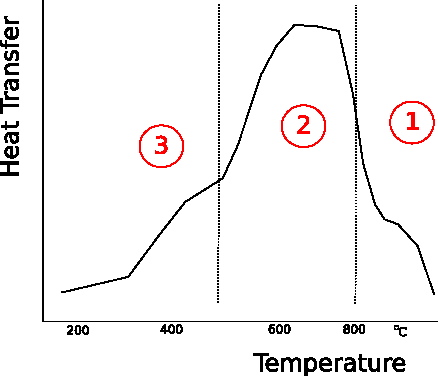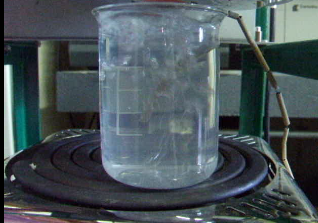

We use the example of casting a molten metal into a mould to illustrate the transfer of heat across a gap (an interface), given by:

where q is the heat flux, h is the thermal conductance of the interface and ΔT the temperature difference between the source and the sink. Values of the heat transfer coefficient vary widely: 10→102 W m-2 K-1 for large air gap; 103→104 for normal castings with gravity contact; 105→106 for excellent contact as in pressure casting. The temperature profile obtained depends on the a comparison of the heat conductance of the interface with that of the whole casting. The thermal conductance of a casting is written K/L where where K is the thermal conductivity of a casting of length L in the direction of heat flow. The ratio of the thermal conductance of the interface (h) to that of the casting, termed the Biot number:

For small Bi the thermal resistance of the interface dominates that of the casting, which therefore remains at approximately a constant temperature. This is called Newtonian cooling.
The mathematical simulation of the time and temperature during the quenching of hot metal into a liquid depends on the accuracy of data such as the heat-transfer coefficient h. Heat transfer during quenching into liquid is complicated when the quench medium forms a gas when heated to high temperatures.

The quenching process is usually categorised into a number of stages.
The images that follow show a sample designed to measure the heat transfer coefficient during the quenching steel into water. The sample is small to ensure a small Biot number. It is much smaller than a similar sample for aluminium due to the lower thermal conductivity of steel.
An accurate knowledge of the heat transfer coefficient should lead to the better estimation of temperature gradients and cooling rates during quenching.
 Heat transfer sample |
 Heat transfer sample |
 Heat transfer sample, showing the thermocouple |
 Heat transfer sample |
 Heat transfer sample, showing the thermocouple |
 Movie of probe being quenched |
Computer programs and data:
| MAP_STEEL_THERMAL | PROGRAM: Model for thermal conductivity of steel. |
| MAP_DATA_THERMAL | DATA: Thermal conductivity data for steel. |
With some steels, it is necessary to rapidly cool a component in order to achieve martensitic transformation and the desired strength and hardness. Rapid cooling is associated with large temperature gradients, which in turn lead to the development of residual stress. The component will distort when the stresses are not uniform. The heterogeneous distribution of the stresses which lead to distortion can be induced either by a nonuniform shape or nonuniform cooling.
The movies below are from experiments conducted by Professor M. Narazaki (Utsunomiya University, Japan) and reproduced with the permission of Dr K. Arimoto for teaching purposes.
There are two movies showing the quenching of a shaft with a keyway parallel to its length. The first movies shows quenching in water and the second in a polymer solution. The latter is associated with more uniform cooling and less distortion. The movies are in MPG format (2 Mb).
 |
 |
 |
 |
 |
 |
 |
 |
 Mathew Peet |
 |
 |
 |
 Mathew again |
 |
 |
 |
 |
 |
 |
 |
 |
 |
 Hala Salman Hasan, pretending to work |
 Hala, not pretending |
| Superalloys | Titanium | Bainite | Martensite | Widmanstätten ferrite |
| Cast iron | Welding | Allotriomorphic ferrite | Movies | Slides |
| Neural Networks | Pearlite | Recrystallisation | Theses |
| PT Group Home | Materials Algorithms |